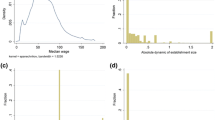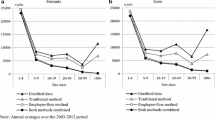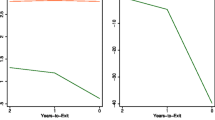Abstract
The Capitalia survey of manufacturing firms in Italy represents an important source of panel data on Italian firms. Panel attrition, however, represents a potential obstacle to such use of the sample. In this paper, sample entry and exit behaviour are studied, and a test for attrition bias is carried out in order to evaluate the potential for using panels constructed from the Capitalia survey. The analysis reveals the presence of distorting panel attrition effects in simple models of firm performance. In addition, the paper discusses both the implications of attrition bias for estimates and also briefly considers possible solutions. Finally, some suggestions are made as to how to reduce the impact of attrition bias through the provision of additional information on the nature of the attrition process available to the surveying institution at the moment of data collection.

Similar content being viewed by others
Notes
Originally, the survey was undertaken under the aegis of Mediocredito Centrale. Mediocredito Centrale is a bank specialising in international finance and industrial finance. In 2002, Mediocredito Centrale was taken over by the Capitalia group—now the third largest banking group in Italy.
Progetto di Ricerca di Interesse Nazionale.
Details of the sample surveys can be found in Mediocredito Centrale (1994) and Capitalia (2002) as well as on: http://www.capitalia.it/pages/studi02b.htm.
Although if one considers the size of the sample in relation to either employment or output, the figure is closer to 10% of the manufacturing total as is pointed out in the report on the eighth wave (Capitalia 2002).
In practice, the first Capitalia sample considered here—the fifth wave covering the years 1989–1991—was based on the Chambers of Commerce database of small and medium sized enterprises constructed by CERVED, a company specialising in the management of business databases.
Possibly the figure of over 100% for the 6th wave is due to the growth of firms between the date of the census (1991) and the date of the survey (1994). Another possibility is that in this wave, firms are included in both questionnaire and balance sheet datasets but are not identified as the same firm in each case.
For simplicity, we consider the case in which the outcome variable, Y, and the survival indicator, S, are determined by variables observed in the previous wave. In practice, it may be desirable in both cases to include variables from the current wave. In particular, in the case of the survival equation, (2), if S is dependent on choices made by the surveying institution at the time of the current wave, these should be included in the specification of Z. For further discussion of this point, see, for example, Rendtel (2002).
Specifically, given the distributional assumptions above, E(ε t |S t * > 0)=ρευσελ where ρευ is the correlation coefficient between ε and υ and λ is the inverse mills ratio. The estimation procedure then simply involves the inclusion of estimated values for E(ε t |S t * > 0) as an additional explanatory variable in Eq. (1).
This is one of the approaches considered by Heckman and Holtz (1989) in their comparison of methods for the evaluation of labour market programmes and is the one used by Bagella et al. (2004) in their analysis of the impact of investment and export subsidies on firm performance using the Capitalia sample. Another possible approach in these circumstances would be through the use of matching models (Rosenbaum and Rubin 1983). See Heckman et al. (1999) for an extensive review of approaches to the evaluation problem as it concerns labour market programmes.
See, for example, the excellent analysis of Battistin et al. (2001). These authors go rather further inasmuch as they recognise that financial support for firms will improve the survival probability of inefficient as well as efficient firms. In most cases the stated aim of such policies is, or certainly should be, to help efficient firms overcome problems with liquidity constraints rather than prolong the survival artificially of inefficient ones. Their analysis is essentially concerned with how one can evaluate such policies in these terms.
The precise methodology for the matching procedure varied between waves according to the available indicators. Specifically, firms were matched on the basis of a unique identifier included in the data (fifth and sixth waves), four indicators of labour costs and value added over time (sixth and seventh waves) and by social security number (seventh and eighth waves).
Given the very high rate of panel attrition, it did not appear useful to construct panels with more than two waves. Appendix includes full descriptive statistics, however, it may be noted here that full information on all four waves is only available for 132 firms.
However the share of firms located in the North decreases in the eight wave.
LIQUIDITY is defined as net working capital /total current liabilities. In the fifth wave, since a variable indicating the net working capital was not available, we tried to construct this variable from the available information using other variables (e.g. short credits, stores in hand, etc.); however, the large number of missing values for the resulting variable led us not to use the liquidity index in the context of the fifth wave.
In previous estimates the set of explanatory variables included also the investments made by the firms in the last 3 years; however, we did not find any significant evidence.
See notes in Table 4 for a description of the performance indicators.
In the fourth column, the results concern the probability that respondents included in the sixth wave were already present in the fifth wave; in column 5, the results concern the probability that respondents included in the seventh wave were already in the panel in the sixth wave; column 6 concerns waves seventh and eighth.
That is, the variable STATE INCENTIVES, as previously defined.
That is, EXPORTING FIRM as previously defined.
More if one accepts the rather broad definition of statistical significance proposed here. Using 20% as a cut-off point for statistical significance is indeed a broader criterion than is conventional; however, we feel that the important concern here is with type II errors. Obviously, lowering the critical level of statistical significance increases the chances of rejecting the null hypothesis of no panel attrition bias when in fact it is true (type I error). By the same token, however, a lower cut-off point reduces the chances of committing a type II error, i.e. of rejecting the hypothesis of panel attrition bias when it is in fact present.
For example, assuming selection on unobservables, this might be achieved by estimating a bivariate probit model of sample selection and panel attrition such as that employed by O’Higgins (1994).
References
Bagella M, Becchetti L, Londono Bedoya DA (2004) Investment and export subsidies in Italy: who gets them and what is their impact on investment and efficiency. Riv Politica Econ 3–4:61–92
Battistin E, Gavosto A, Rettore E (2001) Why do subsidised firms survive longer? An evaluation of a program promoting youth entrepreneurship in Italy. In: Lechner M, Pfeiffer F (eds) Econometric evaluation of labour market policies, ZEW economic studies, vol. 13, Springer, Heidelberg, pp 153–181
Cameron AC, Trivedi PK (2005) Microeconometrics: methods and applications. Cambridge University Press, Cambridge
Capitalia (2002) Indagine sulle imprese manifatturiere: ottavo rapporto sull’industria e sulla politica industriale. Capitalia, Roma
Dennis M J, Rick L (2003) Effects of panel attrition on survey estimates. Paper presented at the 58th annual American association for public opinion research conference, Nashville, TN, 15–18 May 2003
Dionne G, Gagné R, Vanasse C (1998) Inferring technological parameters from incomplete panel data. J Econ 87:303–327
Fitzgerald J, Gottschalk P, Moffitt R (1998) An analysis of sample attrition in panel data: the Michigan panel study of income dynamics. J Hum Resour 33:251–299
Greene W (2003) Econometric analysis, 5th edn. Prentice Hall, Englewood Cliffs
Hausman JA, Wise DA (1979) Attrition bias in experimental and panel data: the Gary income maintenance experiment. Econometrica 47:455–473
Heckman JJ (1979) Sample selection bias as specification error. Econometrica 47:153–161
Heckman JJ, Holtz J (1989) Choosing among alternative methods of estimating the impact of social programs: the case of manpower training. J Am Stat Assoc 84:862–874
Heckman JJ, Lalonde RJ, Smith JA (1999) The economics and econometrics of active labor market programs. In: Aschenfelter O, Card D (eds) Handbook of labor economics. vol. IIIA. Elsevier, Amsterdam, pp 1865–2097
Liao TF (2006) A method for analyzing categorical data with panel attrition. Methodology of Longitudinal Surveys Conference, University of Essex, 12–14 July 2006
Little RJA, Rubin DB (1987) Statistical analysis and missing data. Wiley, New York
Kyriazidou E (1997) Estimation of a panel data sample selection model. Econometrica 65:1335–1364
Maddala GS (1983) Limited dependent and qualitative variables in econometrics. Cambridge University Press, Cambridge
Mediocredito Centrale (1994) Indagine sulle imprese manifatturiere: quinto rapporto sull’industria italiana e sulla politica industriale. Il Sole 24 Ore, Milano
O’Higgins N (1994) Employment and sample selection bias. Oxf Econ Pap 46:605–628
Rendtel U (2002) Attrition in household panels: a survey. CHINTEX, Working paper no. 4, University of Frankfurt
Rosenbaum P, Rubin D (1983) The central role of the propensity score in observational studies for causal effects. Biometrika 70:41–55
Vella F, Verbeek M (1999) Two-step estimation of panel data models with censored endogenous variables and selection bias. J Econ 90:239–263
Verbeek M, Nijman T (1992) Testing for selectivity bias in panel data models. Int Econ Rev 33:681–703
Acknowledgments
Research for this paper was carried out as part of the PRIN 2003 research project “Metodi e applicazioni per la valutazione delle politiche del lavoro e di aiuto alle imprese” for which financial support is gratefully acknowledged. Thanks are due to Maria Guerra who undertook the matching procedure on the data and to Sergio Lugaresi, Attilio Pasetto and Tony Riti from Capitalia, Eric Battistin, Bruno Contini, Sergio Destefanis, Steve Pudney, Ugo Trivellato and an anonymous referee for their helpful comments on a previous version of the paper.
Author information
Authors and Affiliations
Corresponding author
Rights and permissions
About this article
Cite this article
Nese, A., O’Higgins, N. Attrition bias in the Capitalia panel. Int. Rev. Econ. 54, 383–403 (2007). https://doi.org/10.1007/s12232-007-0021-6
Published:
Issue Date:
DOI: https://doi.org/10.1007/s12232-007-0021-6




